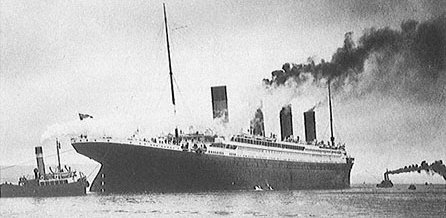


A painting of the Royal Mail Steamer Titanic
Significant Dates:
In 1907, J. Bruce Ismay
(President of the White Star Line) and Lord Pirrie (Chairman of
Harland & Wolff shipbuilders) dreamed up the idea to build
luxurious ocean liners as a way for the White Star Line to compete in
the transatlantic passenger market. A total of three ships were
planned: The Olympic, Titanic and Gigantic. The
next year was spent doing extensive design work.
|
Comparison of the Titanic to the Voyager of the Seas: |
|
|
*Voyager of the Seas (Royal Caribbean) is one of the largest cruise ships in the world today.
Other Titanic specifications:
Draught: 34 feet.

Engines: Two four-cylinder steam
reciprocating engines and one low pressure turbine engine. The
turbine, which drove the center propeller, utilized the exhaust steam
from the other engines. This design recycled the exhausted steam
instead of wastefully venting it up the funnels. The result: an
increase in efficiency.
Building:
Harland and Wolff, located in
Belfast, Ireland, built the Titanic.

The Titanic was:
The Largest ship in the world (in 1912).
Titanic Decks: (listed from top of ship to bottom)
Boat Deck
Shelter Deck ("C")
Deck Highlights
Boat Deck: Bridge; radio room; officer's quarters; lifeboats; gymnasium. |View Deck|
Promenade Deck: 1st class staterooms; 1st class reading and writing rooms; 1st class lounge; 1st class smoking room; the Verandah Cafe and Palm Court. |View Deck|
Bridge Deck: 1st class suites; two 1st class "millionaire" suites; 1st class à la Carte restaurant; Café Parisien restaurant; 2nd class smoking room. |View Deck|
The 1st class passengers boarded the Titanic through the impressive Grand Staircase. It was sixteen feet wide, provided access to seven decks and was over 60 feet high. The ceiling was a massive glass dome which contained a large chandelier.
|
|
|
At the bottom of the stairs was a large statue. This statue has been salvaged from the Titanic wreck. At the top of the stairs was an ornate clock. The Grand Staircase was described as representing, "Honor and Glory crowning Time".
Shelter Deck: 1st class suites; 2nd class library; 3rd class social room; 3rd class smoking room; some crew accommodations; cabins for the maids and servants who accompanied many of the 1st class passengers; 1st class barber shop; Doctor's office; Purser's office; hatches for loading the ship. |View Deck|
Saloon Deck: 1st class dining room; 1st class reception room; 2nd class dining room; 1st and 2nd class galleys (kitchens) and pantries; 1st, 2nd and 3rd class rooms; crew quarters; 1st and 2nd class bakery and butcher shops; hospital. |View Deck|
Upper Deck: 1st, 2nd and 3rd class rooms; crew quarters; 2nd class barber shop. |View Deck|
Middle Deck: Swimming pool; Turkish bath; 2nd and 3rd class rooms; crew quarters; 3rd class dining room; 3rd class galley; 3rd class bakery and butcher shop. |View Deck|
Lower Deck: Squash racquet court; Post Office; food freezers and coolers; baggage rooms; cargo hold; crew quarters; some 3rd class rooms. |View Deck|
Orlop Deck: Engine rooms; boiler rooms; coal bunkers; fresh water tanks; food storage; wine cellar; cargo and refrigerated cargo hold; baggage rooms. |View Deck|
Note: many of the areas on the Titanic traversed multiple decks.
Officers of the Titanic:
|
|
Front row from Left to Right: |
Captain - Edward
J Smith (did not survive)
Others of Significance
Quartermaster- Robert Hitchens (survived)
Lookout-
Frederick Fleet (survived)
Managing Director of Harland
& Wolff- Thomas
Andrews
Managing Director of White Star Lines- J Bruce Ismay (survived)
 played a significant role in the Titanic disaster. It is believed
that Ismay may have influenced Captain Smith to ignore the ice
warnings and steam ahead at full speed. Many are convinced that if
Ismay had not been aboard, Captain Smith would have been more
cautious and taken the ice warnings more seriously.
played a significant role in the Titanic disaster. It is believed
that Ismay may have influenced Captain Smith to ignore the ice
warnings and steam ahead at full speed. Many are convinced that if
Ismay had not been aboard, Captain Smith would have been more
cautious and taken the ice warnings more seriously.
Ismay left the Titanic on collapsible boat C and has been extensively criticized for this. The general feeling was that he should have gone down with the ship. He stated that he only boarded the lifeboat because there were no other passengers waiting to get on board. However, witnesses have reported seeing Ismay push and shove others out of the way to get on that lifeboat. The truth will never be known. Ismay resigned his position in 1912 shortly after the Titanic incident, but remained an executive with IMM (International Mercantile Marine Co -- the owners of the White Star Line) until 1916. He died from a stroke at age 74 in October, 1937.
And the band played on...
None of the eight musicians were employed by the White Star Line. They all worked for Messers C.W. and F.N. Black of Liverpool, England and were ticketed on Titanic as second class passengers.
|
|
|
||
All eight musicians lost their lives.
 Ownership
of Titanic:
Ownership
of Titanic:
The Titanic was part of the White Star Line and was owned by the Oceanic Steam Navigation Company located in England. All of its stock was owned by the the International Navigation Company Ltd of England, which in turn, was owned by the International Mercantile Marine Company (IMMCO) - an American corporation. IMMCO owned the White Star Line.

Definitions:
Conversions:
Miles per Hour = Knots
multiplied by 1.152
Celsius=(Fahrenheit-32)*0.555
| Titanic Home | Top of Page |
![]()
Copyright © 1997-2003. All rights reserved.